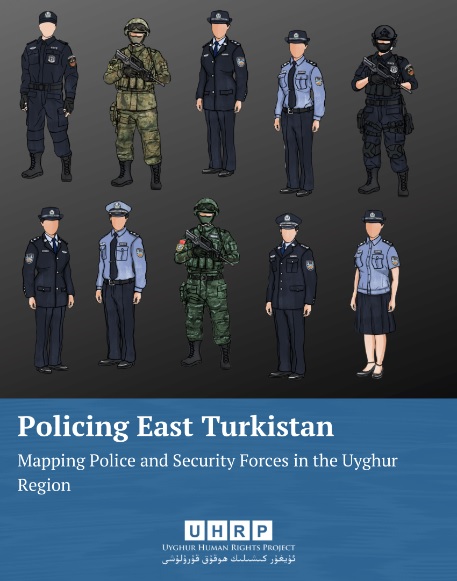A Uyghur Human Rights Project explainer by Ben Carrdus; layout and formatting by Peter Irwin and Haibib Kerim. Read our press statement on the briefing and download the full briefing in English.
I. Key Takeaways
- The police in East Turkistan are among the prime actors in carrying out the genocide arising from the Chinese Communist Party’s (CCP) policies. Policing in East Turkistan is carried out by several agencies with differing duties and separate command structures, some at the local level and some at the national level, but all ultimately under the CCP’s strict control.
- One of these agencies, the People’s Armed Police (PAP), is commanded by the same CCP committee that controls China’s armed forces, although the PAP is not part of the military.
- East Turkistan has more PAP “Mobile Detachments,” similar to an army regiment, than anywhere else in the People’s Republic of China, possibly twice as many as even Beijing despite having a fraction of Beijing’s population, and they are commanded at the same level as Beijing’s PAP – a grade higher than any other provincial-level administration.
- Regional police, and elsewhere in the PRC, are highly adept and specifically coordinated to tackle perceived affronts to the CCP’s authority, but do not perform well in addressing common crime (such as drug crime).
- According to estimates, there are more than twice as many People’s Police, organizationally similar to state police forces in the US, in East Turkistan than elsewhere in the PRC, plus up to 70,000 Assistant Police (short-term, lesser-trained supplementary officers), on top of an unknown number of PAP troops.

II. Summary
A key detail in building a fuller picture of the ongoing genocide in East Turkistan – the systematic and Party-state-sponsored human rights atrocities perpetrated against Uyghurs and other Turkic people – is to understand the institutions of policing there. While it is accurate to describe “the police” under the strict control of the Chinese Communist Party (CCP) as a leading actor in the genocide, as opposed to “the army” or “the authorities” or any other state institution, this doesn’t distinguish the various forms of police in East Turkistan, nor their chains of command.
For the purposes of this explainer, “police” refers to the institutions common to all nations and the personnel within those institutions who are ostensibly tasked with detecting and preventing crime and maintaining public order.
East Turkistan has been described as “one of the most heavily policed regions in the world.”1 There are policing agendas in East Turkistan generally not seen elsewhere in the People’s Republic of China (PRC) or certainly not to the same scale, including most notably what the Chinese authorities define as “the three evils” of religious extremism, terrorism, and separatism, which has provided the impetus for decades of severe human rights violations.
Police in East Turkistan have been instrumental in effectively criminalizing the estimated 1.8 million people – close to one in six of the region’s Uyghur and other Turkic people – arbitrarily held in the region’s large network of detention centers since 2016, many of whom are now either formally sentenced to prison, transferred to forced labor programs, or released under intense police surveillance. According to official statistics, despite East Turkistan’s population constituting only 1.5 percent of the PRC’s total, 20 percent of all police arrests in the PRC in 2017 were in East Turkistan.2 Another prominent feature of policing in the region is the ubiquitous and highly invasive surveillance systems, which for the time being at least are not seen on a comparable scale anywhere else in the PRC.3
According to one conservative estimate, as of 2017, there were 2.3 times more People’s Police (Ch. 人民警察, Renmin jingcha) including Assistant Police and other “security-related positions” in East Turkistan than elsewhere in the PRC: 478 per 100,000 population compared to 212 nationally.4 However, these figures neither include the unknown number of centrally-commanded People’s Armed Police (Ch. 人民武装警察部队, Renmin wuzhuang jingcha budui – see below) in the region, nor include police and paramilitary forces within the Xinjiang Production and Construction Corps (see below), and nor do they factor in the far-ranging involvement of ordinary local government departments in supporting the police.
The purpose of this explainer is to outline policing structures as they are currently understood with a view to providing a broad overview of the roles that the various forms of police play in the ongoing genocide in East Turkistan.
December 13, 2023

